Review
of the Canon EF 300mm f/4 L IS USM Lens
2nd Edition Revised Review
This is a sharp, compact and light weight, image-stabilized lens that
packs a lot of performance into a relatively affordable package. There is
a widespread view that the image stabilized (IS) version of the EF 300mm
f/4 is not quite as sharp as the earlier non-IS view. This revision of my
original view confirms that view.
Strong points of this lens:
- Produces sharp images wide open at f/4
- Light and compact for travel and for multiple body/lens use when
roaming
- Less expensive than the f/2.8 version
- Good hand-holdable performance at slow shutter speeds because of
image stabilization
- Good contrast, color (and bokeh when shot at f/4)
- Makes a reasonably good 420mm lens with the EF 1.4x extender
|
Limitations of this lens:
- f/4 aperture limits use under low ambient lighting
- Bokeh (diffusely blurred out of focus background) is still not
as good as with the f/2.8 lens
|
Performance Data and Images When Used as a 300mm
Lens
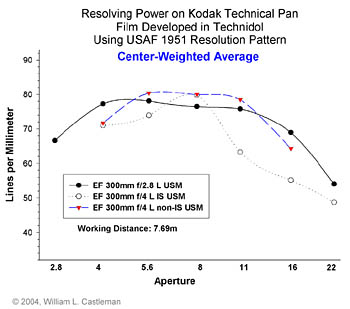 |
I tested the EF 300mm f/4 L IS lens against my EF
300mm f/2.8 L (non-IS) lens and an EF 300mm f/4 L non-IS as
described here.
Center-weighted resolution (60% center, 30% middle; 10% edge) was
excellent from f/4 to f/8. Drop off in resolution was noticeable in film
from f/11 to f/22. The Non-IS f/4L lens has better resolution
performance at f/5.6, 11 and 16 than the IS f/4L lens. |
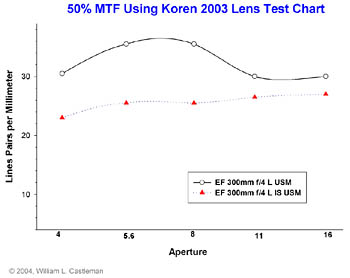 |
I tested 50% modulation transfer function (MTF) using
Koren 2003 lens test charts with an EOS-1Ds using in camera large jpg
mode as described here.
The non-IS version of the f/4L lens has better microcontrast than the IS
version at all apertures tested. |
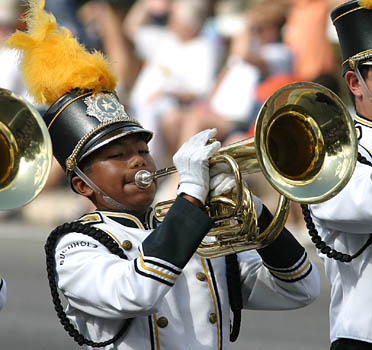
Crop
from Full Size Large Fine JPG File |
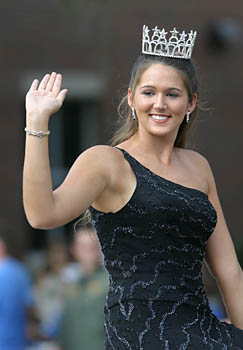
Crop
from Full Size Large Fine JPG File |
Contrast and Detail at f/5.6 of
high school band member in 2003 University of Florida Homecoming Parade.
Subject
detail, contrast and color is excellent, and background clutter along
the parade route is still nicely blurred.
Canon
EOS-10D; EF 300mm f/4 L IS at f/5.6, ISO 400, 1/1600 sec. |
Shot Wide Open: Local beauty
queen in 2003 Univerity of Florida Homecoming Parade. Shooting at f/4
provides plenty of lovely detail while washing out the crowd and brick
building in the background. Lower contrast is present in images at f/4.
Canon
EOS-10D; EF 300mm f/4 L IS at f/4, ISO 200, 1/500 sec. |
Examples of Bokeh and Resolution Comparisons between the EF 300mm
f/4 L IS and EF 300mm f/2.8 with EOS-1Ds and EOS-10D
Comparison
photographs of mannequin here.
The film resolution tests show that the EF 300mm f/2.8 L lens has a
slight resolution edge over the EF 300mm f/4 L IS lens at f/4. Does this
higher resolution on film translate into a detectable difference in images
produced with digital cameras? Tests
with the EOS-1Ds showed that the slightly higher resolution
of the f/2.8 lens is just barely detectable in digital photographs with
this 11 megapixel camera. The difference in resolution is not detectable
with the EOS-10D (6 megapixel camera).
Diffuse background blurring
is slightly better with the EF 300 f/2.8 at f/4 than with the EF 300 f/4
at f/4 as shown in the full field EOS-1Ds images on the mannequin photo
page.
For most photographic applications, differences in photographs
produced by the EF 300mm f/4 L IS USM lens compared to those produced by
the EF 300mm f/2.8 L lens are going to be photographically insignificant.
Performance Data and Images When Used as a 420mm
Lens with an Extender EF 1.4x
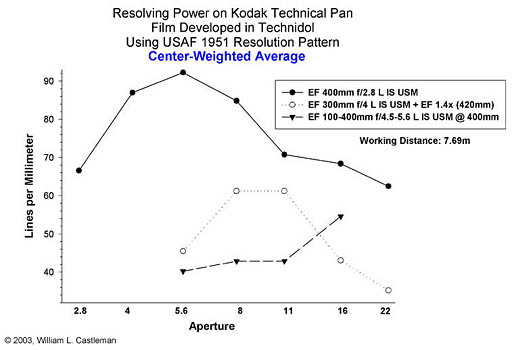 |
Putting a Canon Extender EF 1.4x on the EF 300mm f/4 L
IS yields a reasonably well-performing 420mm lens. However, the
performance window is narrow between f/8 and f/11. Performance is
noticeably better than that for the EF 100-400mm f/4.5-5.6 L IS Zoom at
400mm. Performance pales against that of Canon's latest EF 400mm f/2.8 L
IS lens. |
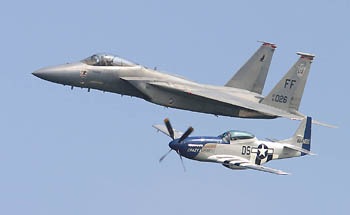
Full
Size Detail Cropped from Converted Raw File
From Image Taken 1
Second Later to Reduce Canopy Reflection |
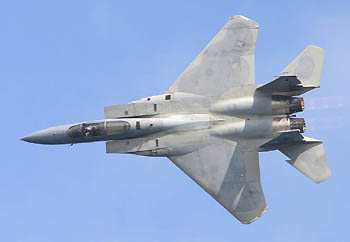
Full
Size Detail Cropped from Converted Raw File |
Good aircraft and cockpit detail is
captured when shooting at 420mm. Heritage flight of F-15 and P-51 at
2003 Wings and Waves Airshow, Daytona Beach, FL
Canon
EOS-10D; EF 300mm f/4 L IS with EF 1.4x @ f/8, ISO 400, 1/1250 sec. |
Cockpit and aircraft port grill detail on
F-15 in tactical demonstration flight. 2003 Wings and Waves Airshow,
Daytona Beach, FL
Canon EOS-10D; EF 300mm f/4 L
IS with EF 1.4x (420mm) @ f/8, ISO 400, 1/800 sec. |
Autofocus Function
Autofocus
performance of the EF 300mm f/4 L IS lens is dependent on camera body.
Autofocus is very fast with the EOS-1D / 1Ds. Autofocus is considerably
slower with the EOS-10D or D-60. Autofocus with the 1.4x extender on the
lens substantially decreases autofocus function. However, I was still able
to track and photograph flying birds with an EOS-1Ds with the 1.4x
extender on the lens. I was unable to directly compare autofocus function
of the IS and non-IS versions of the lens.
|
Image Stabilization
Image stabilization on this lens is a major benefit
This photograph of a female anhinga was taken at 420mm with the
camera hand held at a shutter speed of 1/50th second.
The photographic rule of thumb is that you shouldn't try to handhold
a telephoto lens for photography with the shutter speed slower than
1/focal length. The rule of thumb suggests that I shouldn't try to
photograph this anhinga at less than 1/420 second. The image is
moderately sharp despite the shutter speed being set 8-fold slower
than the recommended shutter speed thanks to Canon's image
stabilization system.
Canon EOS-1Ds; EF 300mm
f/4 L IS with EF 1.4x (420mm) @ f/8, ISO 400, 1/50 sec. hand held |
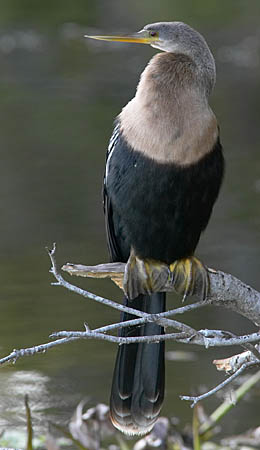 |
Comparison of the IS and Non-IS versions of the f/4L:
I
hesitated buying the IS version of the lens because of information at
photodo.com
cited by many on internet bulletin boards indicating that the newer IS
version did not perform as well optically as did the older non-IS version
of the lens. Photodo.com assesses the optical grade of the IS lens at 3.4
and the older non-IS version at 4.3.
Since posting my original review in November, 2003, Malcolm Stewart
posted Canon
MTF charts on dpreview.com
that had been printed by Canon in 1999 showing that the new IS version of
the lens had at least comparable, if not better, optical performance than
the non-IS version.
My most recent tests confirm that the non-IS version has better
resolution and 50% MTF function than the IS version. However, image
stabilization is a benefit that may be worth the decrease in MTF
performance for many.
Relevant Specifications for the EF 300mm f/4 L IS and EF 300mm f/2.8
IS Lenses from the B&H
Photo Website and
Canon-USA website as of November, 2003.
|
EF 300mm f/4 L IS USM |
EF 300mm f/2.8 L IS USM |
The f/2.8 lens is: |
| Price (Imported) |
$1,140 USD |
$3,800 USD |
3.3 times more expensive |
| Weight |
2.6 lbs (1,190 g) |
5.6 lbs (2,550 g) |
2.14 times heavier |
Size (largest dimensions)
Hood not extended |
3.5 x 8.7 inches (90 x 221 mm) |
5 x 9.9 inches (128 x 252 mm) |
1.6 greater displacement volume without considering
shipping case |
Concluding Opinion
The EF 300mm f/4 L IS USM lens is a very sharp, light, compact,
high-performance telephoto lens. It is a valuable substitute for the EF
300mm f/2.8 L when weight, space (or cost) restrictions do not allow use
of the larger and heavier, slightly more capable lens. Light weight and
image stabilization make it a superb lens to use when you are traveling
without a monopod or tripod.
Link
to Bob Atkins' review of the EF 300mm f/4 L on Photo.net
Equipment
Review Index
Home
©
2003-4, William L. Castleman
Posted
November 11, 2003. Revisions posted November 17, 2003 and new data added
November 7, 2004







